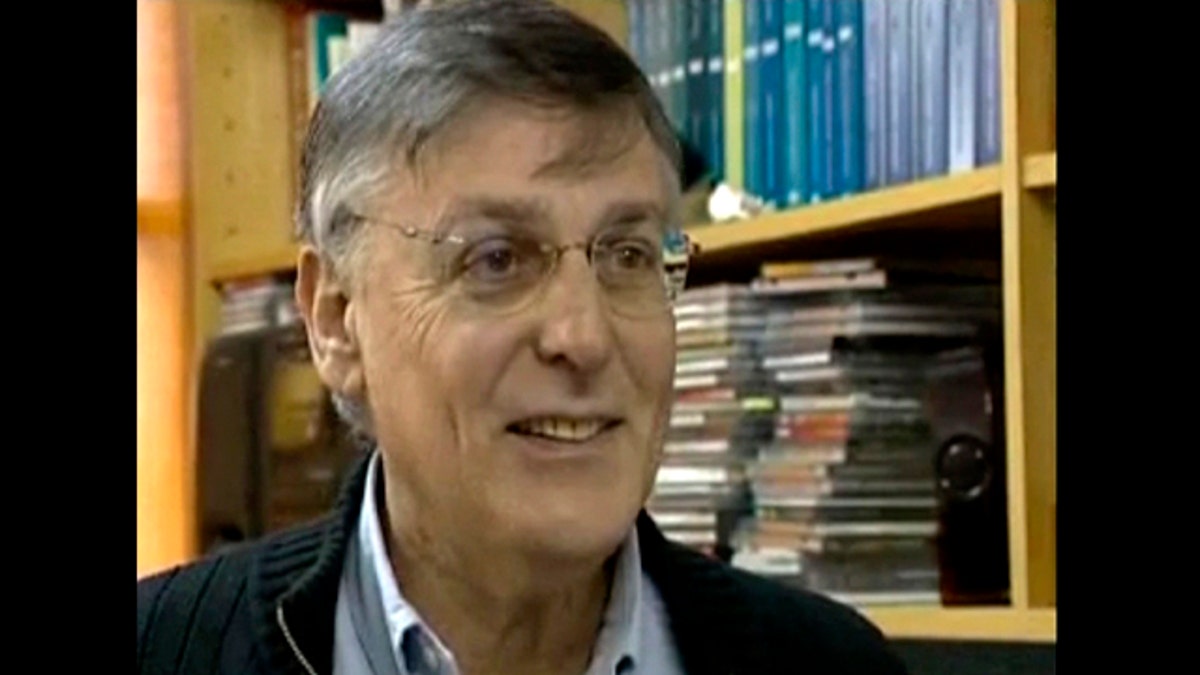
Oct. 5, 2011: Israeli scientist Daniel Shechtman won the 2011 Nobel Prize in chemistry on Wednesday for his discovery of quasicrystals, a mosaic-like chemical structure that researchers previously thought was impossible. ((AP Photo/Israel Channel 10)
STOCKHOLM – Israeli scientist Dan Shechtman was awarded the Nobel Prize in chemistry on Wednesday for a discovery that faced skepticism and mockery, even prompting his expulsion from his U.S. research team, before it won widespread acceptance as a fundamental breakthrough.
While doing research in the U.S. in 1982, Shechtman discovered a new chemical structure -- quasicrystals -- that researchers previously thought was impossible.
He was studying a mix of aluminum and manganese in an electron microscope when he found the atoms were arranged in a pattern -- similar to one in some traditional Islamic mosaics -- that never repeated itself and appeared contrary to the laws of nature.
He concluded that science was wrong -- but it would take years for him and other researchers to prove that he was right.
Since then, quasicrystals have been produced in laboratories and a Swedish company found them in one of the most durable kinds of steel, which is now used in products such as razor blades and thin needles made specifically for eye surgery, the Royal Swedish Academy of Sciences said. Quasicrystals are also being studied for use in new materials that convert heat to electricity. They were first discovered in nature in Russia in 2009.
Despite the initial reluctance in the scientific community to accept his discovery, it "fundamentally altered how chemists conceive of solid matter," the academy said in its citation for the 10 million kronor ($1.5 million) award.
"The main lesson that I have learned over time is that a good scientist is a humble and listening scientist and not one that is sure 100 percent in what he read in the textbooks," Shechtman, 70, told a news conference Wednesday at the Technion-Israel Institute of Technology in Haifa, Israel.
Shechtman is a professor there and at Iowa State University in Ames, Iowa. He will receive the award along with the other Nobel Prize winners at a Dec. 10 ceremony in Stockholm.
Israel has won 10 Nobel prizes, a source of great pride in the country of just 7.8 million people. Schechtman was congratulated by Israeli President Shimon Peres, who shared the Nobel Peace Prize as Israel's foreign minister in 1994, and by Prime Minister Benjamin Netanyahu.
"Every citizen of Israel is happy today and every Jew in the world is proud," Netanyahu said.
In chemical terms, a crystal is traditionally defined as a regular and repeating arrangement of atoms within a material. A quasicrystal presents a pattern that scientists had thought was impossible. The pattern of atoms within a material influences the material's physical properties.
"His battle eventually forced scientists to reconsider their conception of the very nature of matter," the academy said.
Nancy B. Jackson, president of the American Chemical Society called Shechtman's discovery "one of these great scientific discoveries that go against the rules." When Shechtman announced it, other experts hesitated.
"People didn't think that this kind of crystal existed," she said. "They thought it was against the rules of nature."
Only later did some scientists go back to some of their own inexplicable findings and realized they had seen quasicrystals but not realized what they had, Jackson said.
Staffan Normark, permanent secretary of the Royal Swedish Academy said Shechtman's discovery was one of the few Nobel Prize-winning achievements that can be dated to a single day.
Crystallographers always believed that all crystals have rotational symmetry, so that when they are rotated, they look the same. On April 8, 1982, while on a sabbatical at the U.S. National Bureau of Standards and Technology in Washington, D.C., Shechtman first observed crystals with 10 points -- pentagonal symmetry, which most scientists said was impossible.
"I told everyone who was ready to listen that I had material with pentagonal symmetry. People just laughed at me," Shechtman said in a description of his work released by his university.
For months he tried to persuade his colleagues of his find, but they refused to accept it. Finally he was asked to leave his research group, and moved to another one within the institute.
Shechtman returned to Israel, where he found one colleague prepared to work with him on an article describing the phenomenon. The article was at first rejected, but finally published in November 1984 -- to uproar in the scientific world. Double Nobel winner Linus Pauling was among those who never accepted the findings.
"He would stand on those platforms and declare, 'Danny Shechtman is talking nonsense. There is no such thing as quasicrystals, only quasi-scientists."' Shechtman said.
In 1987, friends of Shechtman in France and Japan succeeded in growing crystals large enough for x-rays to repeat and verify what he had discovered with the electron microscope.
"It borders on art," academy member Sara Snogerup Linse said of the quasicrystal patterns. "Humans have created similar patterns in macroscopic scale with the help of ceramic tiles, quilts, etc. But what was new was that it was found also in the world of molecules and atoms."
Cesar Pay Gomez, a structural chemistry expert at Uppsala University in Sweden and an adviser to the prize committee, said research on quasicrystals is ongoing "in the field of thermal-electric applications, where waste heat can be converted to electrical currents or energy."
The Nobel Prize in chemistry announcement capped this year's science awards.
Immune system researchers Bruce Beutler of the U.S. and Frenchman Jules Hoffmann shared the medicine prize Monday with Canadian-born Ralph Steinman, who died three days before the announcement. U.S.-born scientists Saul Perlmutter, Brian Schmidt and Adam Riess won the physics prize on Tuesday for discovering that the universe is expanding at an accelerating pace.
The Nobel Prizes are handed out every year on Dec. 10, the anniversary of award founder Alfred Nobel's death in 1896.
